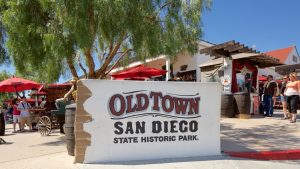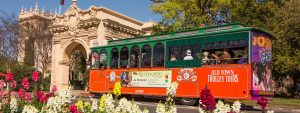Explore the birthplace of California through an eclectic mix of museums, historic sites, shops, restaurants and attractions.
 Stand on the shady porch of the Robinson-Rose House in Old Town State Historic Park and you can catch a glimpse of what San Diego was like in 1855. Where artists now set up easels in the plaza, a scrappy group of ranchers, soldiers and entrepreneurs were constructing what would become California’s second-largest city.
Stand on the shady porch of the Robinson-Rose House in Old Town State Historic Park and you can catch a glimpse of what San Diego was like in 1855. Where artists now set up easels in the plaza, a scrappy group of ranchers, soldiers and entrepreneurs were constructing what would become California’s second-largest city.
Old Town is where the state of California began. Home to the Kumeyaay people since 10,000 BC, the area was claimed for Spain in the mid-sixteenth century by Juan Rodríguez Cabrillo. Settlement didn’t begin in earnest until 1769, when Father Junípero Serra established the first mission at the top of what is now Presidio Hill, and Gaspar de Portolà, Spain’s appointed governor of Alta California, built the first military outpost.
Serra, a 5-foot, 2-inch Franciscan friar with a mighty will, wrote about the area, “It is beautiful to behold and does not belie its reputation.” But Presidio Hill lacked access to water, so the mission was moved upriver to its present site.
When the Mexican War of Independence ended Spanish rule in 1821, San Diego was considered a Mexican pueblo, or village. The fort was abandoned and attention turned to more accessible areas around the base of the hill. Homes and businesses began to spring up.
With the Treaty of Guadalupe Hidalgo in 1848, California became part of the United States, officially achieving statehood on September 9, 1850.
The modest village remained the hub of San Diego life until 1867, when Alonzo Horton purchased 900 acres closer to the waterfront for $265, naming it “New Town.” It would grow to become the city and county seat, now downtown San Diego.
 A century later, the California Department of Parks and Recreation established Old Town State Historic Park, with more than two dozen buildings depicting life from the early Mexican-American period of 1821-1872. Five original adobe structures mix with reconstructed sites and newer buildings done in the same style. A major overhaul reinvigorated the park in 2009, balancing authenticity with contemporary boutiques, restaurants and art studios. Many of the attractions are free. On evenings and weekends, take advantage of free parking behind the CalTrans building on the northwest side of Taylor Street. It’s a short walk from there to Old Town.
A century later, the California Department of Parks and Recreation established Old Town State Historic Park, with more than two dozen buildings depicting life from the early Mexican-American period of 1821-1872. Five original adobe structures mix with reconstructed sites and newer buildings done in the same style. A major overhaul reinvigorated the park in 2009, balancing authenticity with contemporary boutiques, restaurants and art studios. Many of the attractions are free. On evenings and weekends, take advantage of free parking behind the CalTrans building on the northwest side of Taylor Street. It’s a short walk from there to Old Town.
Make your first stop at the Visitor Center in the Robinson-Rose House, erected in 1853, demolished around 1900 and rebuilt in 1989. It was once the home of self-taught attorney James Robinson and his wife Sarah, a mysterious couple with a scandalous — for the era — past. Sarah later sold the house to Louis Rose, a German immigrant and one of San Diego’s first Jewish settlers. Over the years it heldlaw and medical offices, a jail, school, newspaper headquarters, store, boarding house and the county clerk’s office. Pick up maps and brochures, find the camel in the diorama, and sign up for a guided walking tour of the park.
Across the plaza is La Casa de Estudillo, a grand adobe home that served as the social and political center of fledgling San Diego. Built between 1827 and 1830 for José Maria Estudillo, commander of the Presidio fort, it remained in the Estudillo family for roughly 60 years. The house and courtyard functioned as a school, chapel and place of refuge for women and children during the U.S. invasion of 1846. Local legend held that it was a setting in Helen Hunt Jackson’s fictionalized book, “Ramona. Read More Here Now…


